Notch signaling is required for the formation of mesangial cells from a stromal mesenchyme precursor during kidney development
- PMID: 24353058
- PMCID: PMC4074211
- DOI: 10.1242/dev.100271
Notch signaling is required for the formation of mesangial cells from a stromal mesenchyme precursor during kidney development
Abstract
Mesangial cells are specialized pericyte/smooth muscle cells that surround and constrain the vascular network within the glomerulus of the kidney. They are derived from the stromal mesenchyme, a progenitor population distinct from nephron stem cells. Whether mesangial cells have a distinct origin from vascular smooth muscle cells (VSMCs) and the pathways that govern their specification are unknown. Here we show that Notch signaling in stromal progenitors is essential for mesangial cell formation but is dispensable for the smooth muscle and interstitial cell lineages. Deletion of RBPjk, the common DNA-binding partner of all active Notch receptors, with Foxd1(tgCre) results in glomerular aneurysm and perinatal death from kidney failure. This defect occurs early in glomerular development as stromal-derived, desmin-positive cells fail to coalesce near forming nephrons and thus do not invade the vascular cleft of the S-shaped body. This is in contrast to other mutants in which the loss of the mesangium was due to migration defects, and suggests that loss of Notch signaling results in a failure to specify this population from the stroma. Interestingly, Pdgfrb-positive VSMCs do not enter the vascular cleft and cannot rescue the mesangial deficiency. Notch1 and Notch2 act redundantly through γ-secretase and RBPjk in this process, as individual mutants have mesangial cells at birth. Together, these data demonstrate a unique origin of mesangial cells and demonstrate a novel, redundant function for Notch receptors in mesangial cell specification, proliferation or survival during kidney development.
Keywords: Foxd1; Kidney; Mesangium; Mouse; Notch; Progenitors.
Figures
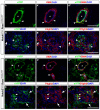
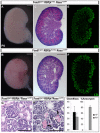

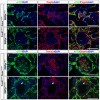
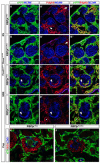


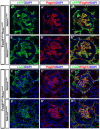
Similar articles
-
The Mesangial cell - the glomerular stromal cell.Nat Rev Nephrol. 2021 Dec;17(12):855-864. doi: 10.1038/s41581-021-00474-8. Epub 2021 Sep 10. Nat Rev Nephrol. 2021. PMID: 34508249 Review.
-
Physiological notch signaling maintains bone homeostasis via RBPjk and Hey upstream of NFATc1.PLoS Genet. 2012;8(3):e1002577. doi: 10.1371/journal.pgen.1002577. Epub 2012 Mar 22. PLoS Genet. 2012. PMID: 22457635 Free PMC article.
-
Metanephric mesenchyme-derived Foxd1+ mesangial precursor cells alleviate mesangial proliferative glomerulonephritis.J Mol Med (Berl). 2019 Apr;97(4):553-561. doi: 10.1007/s00109-019-01749-1. Epub 2019 Feb 27. J Mol Med (Berl). 2019. PMID: 30810761
-
Both Notch1 and Notch2 contribute to the regulation of melanocyte homeostasis.Pigment Cell Melanoma Res. 2008 Feb;21(1):70-8. doi: 10.1111/j.1755-148X.2007.00423.x. Pigment Cell Melanoma Res. 2008. PMID: 18353145
-
Stem cells in the embryonic kidney.Kidney Int. 2008 Apr;73(8):913-7. doi: 10.1038/sj.ki.5002784. Epub 2008 Jan 16. Kidney Int. 2008. PMID: 18200005 Review.
Cited by
-
Dicer1 activity in the stromal compartment regulates nephron differentiation and vascular patterning during mammalian kidney organogenesis.Kidney Int. 2015 Jun;87(6):1125-40. doi: 10.1038/ki.2014.406. Epub 2015 Feb 4. Kidney Int. 2015. PMID: 25651362 Free PMC article.
-
ADAMs family in kidney physiology and pathology.EBioMedicine. 2021 Oct;72:103628. doi: 10.1016/j.ebiom.2021.103628. Epub 2021 Oct 12. EBioMedicine. 2021. PMID: 34653870 Free PMC article. Review.
-
Paragangliomas arise through an autonomous vasculo-angio-neurogenic program inhibited by imatinib.Acta Neuropathol. 2018 May;135(5):779-798. doi: 10.1007/s00401-017-1799-2. Epub 2018 Jan 5. Acta Neuropathol. 2018. PMID: 29305721 Free PMC article.
-
The Mesangial cell - the glomerular stromal cell.Nat Rev Nephrol. 2021 Dec;17(12):855-864. doi: 10.1038/s41581-021-00474-8. Epub 2021 Sep 10. Nat Rev Nephrol. 2021. PMID: 34508249 Review.
-
Embryonic Kidney Development, Stem Cells and the Origin of Wilms Tumor.Genes (Basel). 2021 Feb 23;12(2):318. doi: 10.3390/genes12020318. Genes (Basel). 2021. PMID: 33672414 Free PMC article. Review.
References
-
- Boyle S., Misfeldt A., Chandler K. J., Deal K. K., Southard-Smith E. M., Mortlock D. P., Baldwin H. S., de Caestecker M. (2008). Fate mapping using Cited1-CreERT2 mice demonstrates that the cap mesenchyme contains self-renewing progenitor cells and gives rise exclusively to nephronic epithelia. Dev. Biol. 313, 234–245 - PMC - PubMed
Publication types
MeSH terms
Substances
Grants and funding
LinkOut - more resources
Full Text Sources
Other Literature Sources
Molecular Biology Databases
Miscellaneous

